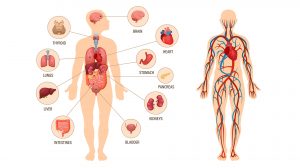Bryophytes

“Physcomitrella patens” (bryophyte, moss species)
Table of Contents
Bryophytes (nonvascular plants) do not have xylem or phloem. The habitations of this plant group are widely varied and include bare rocks in the scorching sun to frozen alpine slopes. They include mosses, liverworts and hornworts. These groups of plants require external water, usually in the form of dew or rain. Some of them grow exclusively in dark, damp environments in order to provide moisture. Water is essential for reproductive activities. For instance, most mosses have water-conducting cells called hydroids in the centers of their stems, and some even have food conducting cells called leptoids. These cells are not nearly as efficient as xylem and phloem and generally, bryophytes are not very tall plants. The lack of vascular tissue leaves the plant body very soft and pliable.
As for the alternation of generations in non-vascular plants, the gametophyte generation is the ‘leafy’ plant that is generally visible (as opposed to the vascular plants whose sporophyte generation is the form that is generally visible). The sporophyte generation that produces spores is located at the tips of the ‘leafy’ gametophyte generation. The sporophyte generally looks like a slender stalk with a cap on top. While the lifecycles of all bryophytes are similar and even their chromosome number and habituation have similarities; they are divided into three distinct groups based on the few differences in structure and reproduction.
Three Major Groups of Bryophytes
Liverworts (Division Hepaticophyta)
Wort means plant or herb, and in ancient times herbalists thought that some of them —specifically the ones that look like liver lobes— were useful in treating liver ailments. Although, the belief was discounted the name stuck.
Structure
About 20% of the liverworts have a flattened, somewhat leaf-like body called a thallus (plural thalli). They lack true stomata, which are present in hornworts and mosses. The other 80%, which aren’t as common in nature, are ‘leafy’ and look more like mosses. Mosses are more complex than liverworts. They have one-celled rhizoids on their lower surfaces. The rhizoids look like tiny roots and anchor the plants to surfaces and soil particles. The thalli are the gametophyte generation and develop almost directly from spores. They have smoother upper surfaces and the cell wall corners are thickened.
Thalloid liverworts
Marchantia is the best-known species of thalloid liverwort. It can usually be found on damp soil after a fire. Marchantia can reproduce asexually and sexually. Asexual reproduction is accomplished through gemmae, which are tiny lens-shaped pieces of tissue that detach from the thallus. Gemmae cups are produced along the upper surface of the gametophyte. Raindrops splash onto the cups and the cups detach and may splash up to 3 feet away from the ‘parent’ gametophyte. Lunularic acid inhibits the Gemmae from growing, as soon as it is out of the cup, though, the inhibition is removed and each may develop into a new thallus. Sexual reproduction in the Marchantia involves the interaction between spores on separate male and female gametophytes. The gametangia are formed on gametophores, or umbrella-like structure on long stalks. The stalks are positioned between the grooves of the thallus.
The male gametophore is shaped like a disc with a scalloped edge, while the female gametophore looks like the hub and spokes of a wheel. the male gametangia are called antheridia, contain numerous sperms, and are produced in rows just beneath the upper surface of the antheridiophore. The female gametangia are flask-like and each one contains a single egg. They are produced in rows and hang with their neck downward from the archegoniophore. Rain will splash and release the flagellated sperm cells. The stalks of the archegoniophores may not be finished growing at the time of fertilization. The zygote, fertilized egg, will develop into a multicellular embryo (a.k.a. immature sporophyte) which is anchored from the tissues of the archegoniophore by a knoblike foot. The foot is connected to the sporophyte (also referred to as the capsule, out of which develops the various type of tissues) by a short, thick stalk called the seta. Inside the capsule, spore mother cells undergo meiosis which results in haploid spores. Some capsule cells do not undergo meiosis, but remain diploid and develop into elaters, which are long and pointy and responsive to changes in humidity. The elaters will twist and untwist rapidly in order to disperse the spores. The young sporophyte will be protected until maturity by a caplike tissue called the calyptra. There are other variations of this cycle in the other thalloid forms. In some floating or amphibious liverworts, the spores are freed only as the thallus decays.
“Leafy” liverworts
These liverworts are usually found in tropical jungles of fog belts. They have two rows of partially overlapping ‘leaves’ in which the cells contain distinctive oil bodies. They are of course, not true leaves. They do have folds and lobes that collect water and usually house tiny animals. The male and female gametangia produce antheridia and archegonia in cuplike structures. When the sporophytes mature they will germinate and produce a protonema which has photosynthetic cells and will develop into a new gametophyte plant.
Hornworts (Division Anthocertophyta)
The mature sporophytes of a hornwort look like miniature green cattle horns. Their gametophyte generation looks similar to filmy versions of thalloid liverworts. Hornworts are rare in arctic regions and are usually found in moist, shady areas, although some do grow on trees. They have between one and eight chloroplasts—usually just one—and the chloroplasts have pyrenoids similar to green algae.
Asexual reproduction
They can reproduce asexually by fragmentation or by developing lobes that are separate from the main part of the thallus.
Sexual reproduction
Hornworts also reproduce sexually and the plants can be unisexual, like mosses and liverworts, or they can be bisexual, meaning the archegonia and antheridia are on the same plant. The sporophytes are distinctive in form and contain numerous stomata. They do not have stalks, setae, and look instead like tiny broom handles rising out of the gametophyte generation. Meristematic tissue at the base of the sporophyte continually increases the length of the sporophyte until conditions are favorable and the axis (central core) undergoes meiosis to produce spores. The sporophyte tip will split and the spores will be dispersed as the horn peels into ribbon-like segments.
Mosses
Subclasses
There are three subclasses of mosses: peat mosses, true mosses, and rock mosses. They share similar reproductive and life cycles and they are all distinct from other plant organisms. Moss ‘leaves’ do not have mesophyll and veins, and all the ‘leaf’ cells are haploid. The cells in the ‘leaf’ do contain numerous lens-shaped chloroplasts, except in the midrib. Mosses have transparent water-storage cells that chloroplasts, yet aid in absorbing water and thus providing moisture to the avascular plant. Mosses also have root-like multicellular rhizoids (unlike liverworts and hornworts that have single-celled rhizoids). The rhizoids do provide for some water absorption, however, most of the water for the plant travels up the moss surface by way of capillarity.
Asexual reproduction
This reproductive process does not rely on a sexual cycle and its alternation of generations, instead it has been demonstrated that moss fragments can produce protonemata that will ‘bud’ and develop into gametophyte mosses.
Sexual reproduction
Mosses produce gametangia on the same plant or on separate plants. Commonly, the gametangia are produced on the same plant. The multicellular antheridia and archegonia are produced at the tips of ‘leafy’ shoots. The individual archegonium has a cavity, the venter with a single egg, and a neck through which the sperm gains access to the egg. Sperm cells are produced in the antheridia. Upon fertilization, the zygote develops into an embryo that remains attached to the gametophyte by an embedded foot. The embryo develops into a sporophyte with a capsule and a seta, a stalk. The gametophyte produces a calyptra which partially covers the capsule. Inside the capsule, spore mother cells undergo meiosis and produce spores which are then released through the teeth of the peristome located at the tip of the capsule. Until spore maturity, the peristome is protected by an operculum, which will fall off at maturity. After the spores germinate, protonemata will ‘bud’ and develop into gametophyte mosses.
You will also like...

Still Freshwater & Plants
Plants in lentic habitats have features not found in terrestrial plants. They acquired these features as they adapt to t..

The Evolution of Cell Organelles
The nucleus containing the genetic material, DNA, and the mitochondria, well-identified as the "powerhouse of the cell",..

Indicator Species and Endangered Species
Certain species are capable of expressing characteristics indicative of the state of the ecosystem they occupy. They are..

The Human Physiology
Physiology is the study of how living organisms function. Thus, human physiology deals specifically with the physiologic..

The Water Cycle
The water cycle (also referred to as the hydrological cycle) is a system of continuous transfer of water from the air, s..

The Evolutionary Development of Multicellular Organisms
Multicellular organisms evolved. The first ones were likely in the form of sponges. Multicellularity led to the evolutio..
